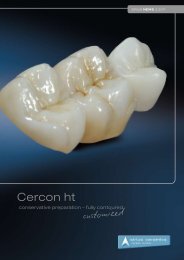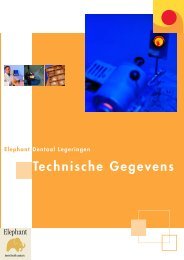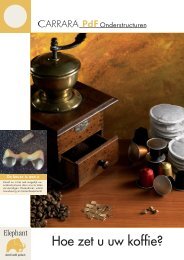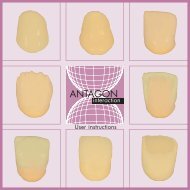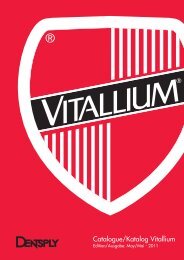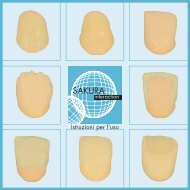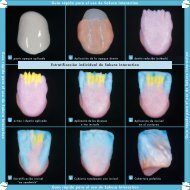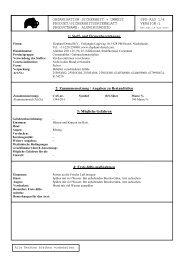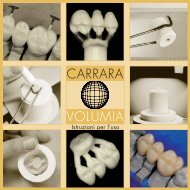DIRECTIONS FOR USE MODE D'EMpLOI ISTRUzIONI pER L'USO ...
DIRECTIONS FOR USE MODE D'EMpLOI ISTRUzIONI pER L'USO ...
DIRECTIONS FOR USE MODE D'EMpLOI ISTRUzIONI pER L'USO ...
Create successful ePaper yourself
Turn your PDF publications into a flip-book with our unique Google optimized e-Paper software.
IndicationsVitallium Special Alloy is a predominantly base metalalloy indicated for casting subperiosteal implants.Contraindications1. Vitallium Special Alloy is contraindicated forpatients and users with a history of sensitivity tocobalt, chromium, and molybdenum.Warnings1. Prolonged exposure to alloy dust and/or fumes maylead to lung irritation, and/or pulmonarycomplications. Use appropriate engineering controlsto limit exposure. For excessive inhalation of dust orfumes, seek medical advice.2. This alloy contains chromium. Some compounds ofthis element are potential carcinogens. Advise yourhealth care provider of exposure to this element.3. This alloy contains elements that are known to theState of California to be carcinogenic.precautions1. When melting, grinding, or polishing alloys, useadequate ventilation, vacuum systems, protectiveeyewear, and protective masks and clothing.AdverseReactions1. Exposure to alloy dust or fumes may cause eyeirritation and/or respiratory complications.2. Certain components of alloys are potentialcarcinogens. See Warnings.STEP BY STEP INSTRUCTIONSpROCESSINgINSTRUCTIONSInvestmentRecommendations:Use DENTSPLY Austenal’s Ethyl Silicate BondedInvestment System:ReOrder#VR Investment ........................................... N022065VR Binder...................................................... N023001VR Binder Thinner.......................................... N024001DuplicatingMaterialRecommendations:Use perflex® Reversible Hydrocolloid DuplicatingMaterial (ReOrder# N021055) with VR Investment.Silflex® III Polyvinyl Siloxane Duplicating Material(ReOrder# N021501) is recommended for use for modelduplication for cases with precision attachments and forcombination cases.NOTE:Followtheinstructionsfortheinvestmentandduplicatingmaterialthatyouareusingforrefractorymodelandinvestingsteps.EQUIpMENTbURNOUTFURNACEREQUIREMENTSForVRInvestment:High temperature gas fired burnoutfurnace capable of attaining 2150°F (1177°C).CASTINgMACHINES: DENTSPLY Austenal ECM IVCasting Machine or a Torch Casting Machine - i.e.Oxygen acetylene multi-orifice torch & spring activatedcentrifugal casting arm.bURNOUTINSTRUCTIONS: Preheat the investmentmolds and a clean casting crucible following therecommended burnout cycle for the investment beingused. Make sure that crucibles are only used for thisalloy and that used crucibles are clean of slag and anyremaining metal.CASTINgINSTRUCTIONS: VirginMetal/RevertRatio:100% virgin metal is recommended when casting dentalimplants.DENTSpLY AUSTENALECMIVCASTINgMACHINESETTINgSCasting Temperature Setting: .... 2820°F Vitallium ScaleSoak Timer: ................................................. 5 secondsMelt Selector Switch:....................................... On HighAccelerationReducerSetting:Small Castings - 50 Large Casting - 75 to 100RPM: 380-400Adjust centrifugal arm counter weight to the properposition to provide for a smooth and balanced castingoperation.Follow the instructions for the machine that you areusing. Melt and cast the alloy into the preheatedinvestment mold and allow the molds to bench coolbefore further processing.DO NOT <strong>FOR</strong>CE COOL OR QUENCH THE MOLDS AS IT MAYCA<strong>USE</strong> WARPAGE OF THE CASTINGS & UNDESIRABLECHANGES IN THE MECHANICAL PROPERTIES OF THE ALLOY.TORCHCASTINgINSTRUCTIONS:Warning: Use extreme caution during torch meltingoperations. Follow the instructions and warnings of thetorch manufacturer and wear eye protection designedfor use when operating an oxygen acetylene torch.Use 3-5 turns on the casting arm depending on thetension of the spring. Set the counter weights at thecorrect position according to the size of the case tobe cast.Use a multi-orifice oxygen acetylene torch pressureregulators and flow meters.Place the preheated mold and crucible in the castingmachine. Place the required amount of alloy inthe crucible.Light the torch and with a circular motion move theflame slowly over the metal. Continue this motion touniformly heat and melt the alloy. When the alloybegins to melt, the ingots and buttons will collapse.Add flux and continue to uniformly heat the alloy untilthe molten alloy can be seen to slump and move underthe pressure of the flame. DO NOT overheat the alloy.Note:Theoxidefilmshouldnotbreak.Release the casting arm and allow the arm to coast to acomplete stop. Remove the mold and allow it to benchcool before further processing.DO NOT <strong>FOR</strong>CE COOL OR QUENCH THE MOLDS AS IT MAYCA<strong>USE</strong> WARPAGE OF THE CASTINGS & UNDESIRABLECHANGES IN THE MECHANICAL PROPERTIES OF THE ALLOY.FINISHINgANDSURFACEpREpARATIONRefer to ASTM 86-84 Standard Practice for surfacepreparation and making of metallic surgical implants forrecommended cleaning and passivation procedures.pHYSICAL&MECHANICALpRO<strong>pER</strong>TIES0.2% Yield Strength ................... 83,000 psi (572 MPa)Ultimate Tensile Strength ......... 116,000 psi (799 MPa)Modulus of Elasticity..................29,000 kpsi (200 GPa)Percent Elongation .............................................. 7.0%Vickers Hardness ........................................... 410 HV5Density ........................................................... 8.3 g/ccMelting Range ................. 2375-2500°F (1300-1370°C)Composition(%bymass)Cobalt (Co)............................................................. 61.6%Chromium (Cr)........................................................ 29.5%Molybdenum (Mo) .................................................... 6.5%Mn, Si, C < 1,0%Nickel and Beryllium Free AlloyIndicationsL’alliage spécial en vitallium est essentiellement un alliageen métal précieux indiqué pour la coulée des implantsjuxtaosseux.Contre-indications1. L’alliage Vitallium Special est contre-indiqué chez lespatients et les utilisateurs avec des antécédents desensibilités au cobalt, au chrome et au molybdène.Avertissements1. Une exposition prolongée aux poussières et auxvapeurs d’alliage peut entraîner une irritation despoumons et/ou des complications pulmonaires.Utilisez les moyens et équipements appropriés pourlimiter l’exposition. En cas d’inhalation excessive depoussières ou de vapeurs, consultez un médecin.2. Cet alliage contient du chrome. Certains composés decet élément sont cancérogènes. Informez votremédecin de votre exposition à cet élément.3. Cet alliage contient des éléments que l’Etat deCalifornie sait qu’ils sont cancérigènes.précautions1. Lors de la fonte, du meulage ou du polissage desalliages, utilisez une ventilation, des systèmes sousvide, des protections oculaires et des masques etvêtements de protection adéquats.Effetsindésirables1. L’exposition aux poussières ou aux vapeurs de l’alliagepeut entraîner une irritation oculaire et/ou descomplications pulmonaires.2. Certains composants de ces alliages sontcarcinogènes. Reportez-vous aux avertissements.INSTRUCTIONS PAS-À-PASINSTRUCTIONSRELATIVESAUTRAITEMENT:Recommandationsentermesderevêtement :Utiliser un système de revêtement lié au silicate d’éthyleAustenal de DENTSPLY :Nº de référenceRevêtement VR ........................... N022065, EU8022065VR Binder ........................................N023001, EU8023005VR Binder Thinner............................N024001, EU8024005Recommandationsentermesdematériaudeduplication:Utiliser un matériau de duplicationhydrocolloïde réversible perflex® (Nº de référenceN021055) avec revêtement VR.Il est recommandé d’utiliser le matériau de duplicationsiloxane de polyvinyle Silflex®III (Nº de référenceN021501) pour la duplication de modèle pour les prothèsesamovibles à fixations de précision et pour les prothèsesamovibles combinées.REMARQUE :Suivrelesinstructionsenmatièrederevêtementetdematériaudeduplicationencoursd’utilisationpourlesétapesderevêtementetdemodèleréfractaire.MATERIEL :CRITEREDUFOURDECHAUFFE :pourlerevêtementVR :Un four de chauffe au gaz hautetempérature capable d’atteindre 2150 °F (1177 °C).MACHINEACOULER : Machine à couler ECM IV AustenalDENTSPLY ou une machine à couler au chalumeau – àsavoir, un bras à couler centrifuge activé par ressort et auchalumeau à orifices multiples oxyacétylénique.INSTRUCTIONSDECHAUFFE : Préchauffer les moules derevêtement et un creuset propre pour coulée suivant lecycle de brûlage recommandé pour le revêtement utilisé.S’assurer que les creusets sont utilisés uniquement pourcet alliage et que les creusets utilisés sont exempts detoutes scories et de tout résidu de métal.INSTRUCTIONSDECOULEE : Rapportmétaldepremièrefusion/recyclage : Un métal 100 % pur est recommandélors de la coulée des implants dentaires.pARAMETRESDELAMACHINEàCOULERECMIVAUSTENALDENTSpLYParamètres detempérature de coulée : ..... Graduation Vitallium 2820°FMinuteur de trempage :...................................5 secondesCommutateur pour le choixdu mode de fusion :................................Sur High (élevé)pARAMèTRESDURéDUCTEURD’ACCéLéRATION :Petites pièces de coulé - 50Grandes pièces de coulée - 75 à 100 Tr/min. : 380-400Ajuster le contrepoids du bras centrifuge sur la positionadéquate afin de l’adapter à une opération de pièce decoulée homogène et équilibrée.Suivre les instructions correspondant à la machine encours d’utilisation. Fondre et couler l’alliage dans le moulede revêtement préchauffé et laisser les moules refroidiravant de poursuivre le traitement.NE PAS <strong>FOR</strong>CER LE REFROIDISSEMENT OU TREMPER LESMOULES. EN EFFET, CELA POURRAIT ENTRAINER UNGAUCHISSEMENT DES PIECES DE COULEE ET DESMODIFICATIONS INDESIRABLES DES PROPRIETESMECANIQUES DE L’ALLIAGE.INSTRUCTIONSDECOULEEAUCHALUMEAU :Avertissements: Procéder avec beaucoup de soin lorsdes opérations de fusion au chalumeau. Se conformer auxinstructions et avertissements du fabricant du chalumeauet porter des protections oculaires conçues pour êtreutilisées lors de l’utilisation d’un chalumeauoxyacétylénique.Utiliser 3–5 tours sur le bras à couler en fonction de latension du ressort. Définir le contrepoids sur la bonneposition selon la taille de la prothèse amovible à couler.Utiliser des débitmètres et régulateurs de pression dechalumeau oxyacétylénique à orifices multiples.Placer le moule et le creuset préchauffés dans la machine àcouler. Placer le volume requis d’alliage dans le creuset.Allumer le chalumeau et, d’un mouvement circulaire,déplacer doucement la flamme sur le métal. Poursuivre cemouvement pour chauffer et fondre uniformément l’alliage.Lorsque l’alliage commencera à fondre, les lingots etboutons s’effondreront. Ajouter du fondant et continuer àchauffer uniformément l’alliage jusqu’à ce que l’alliagefondu s’effondre et bouge visiblement sous la pression dela flamme. NE PAS surchauffer l’alliage.Remarque :Lacouched’oxydenedoitpassebriser.Relâcher le bras à couler et laisser le bras glisser jusqu’àl’arrêt complet. Enlever le moule et le laisser refroidir avantde poursuivre le traitement.NE PAS <strong>FOR</strong>CER LE REFROIDISSEMENT OU TREMPERLES MOULES. EN EFFET, CELA POURRAIT ENTRAINERUN GAUCHISSEMENT DES PIECES DE COULEE ETDES MODIFICATIONS INDESIRABLES DES PROPRIETESMECANIQUES DE L’ALLIAGE.IFINITIONETpRépARATIONDELASURFACEReportez-vous à ASTM 86-84 Standard Practice pour lapréparation des surfaces et la fabrication des implantsmétalliques chirurgicaux servant aux procédures denettoyage et de passivation recommandées.pROpRIETESpHYSIQUESETMECANIQUESLimite d’élasticité 0,2 %................. 83,000 psi (572 MPa)Force de traction ultime ................. 116,000 psi (799 MPa)Module d’élasticité .........................29,000 kpsi (200 GPa)Coefficient d’allongement ........................................ 7,0 %Dureté Vickers ..................................................... 410 HV5Densité ................................................................ 8,3 g/ccIntervalle de fusion........... 2375–2500 °F (1300–1370 °C)Composition(%delamasse)Cobalt .................................................................... 61,6%Chrome................................................................... 29,5%Molybdène ............................................................... 6,5%Mn, Si, C < 1,0%L’alliage Vitallium Special ne contient ni nickel nibéryllium.IndicazioniLa lega speciale di vitallio è una lega metallica di baseindicata oprattutto negli impianti sottoperiostei di fusione.Controindicazioni1. La lega Vitallium Special è controindicata nei pazientie utilizzatori con anamnesi di sensibilità al cobalto,cromo, e molibdeno.Avvertenze1. Una prolungata esposizione alle polveri/o vapori dellalega possono portare a irritazione e/o complicazionipolmonari. Adottare adeguati controlli tecnologici perlimitarne l’esposizione. In presenza di un’eccessivainalazione a polveri o vapori rivolgersi ad un medico.2. Questa lega contiene cromo. Alcuni composti di questielementi sono potenzialmente carcinogeni. Informare ilproprio medico curante dell’esposizione a questielementi.3. Questa lega contiene elementi noti come cancerogeniallo Stato della California.precauzioni1. Durante la procedura di fusione, molatura o lucidaturadi leghe, instaurare una ventilazione adeguata assiemea sistemi del vuoto e indossare occhiali, maschere eindumenti protettivi.Effetticollaterali1. L’esposizione a polveri e vapori della lega possonocausare irritazione oculare e/o complicazionirespiratorie.2. Certi componenti delle leghe sono potenzialmentecarcinogeni. Vedere Avvertenze.ISTRUZIONI FASE PER FASE<strong>ISTRUzIONI</strong>DITRATTAMENTOSuggerimentisulrivestimento:Utilizzare un sistema di rivestimento fissato con etilsilicatoDENTSPLY Austenal:.Numero per il riordinoRivestimento VR..........................N022065, EU8022065VR Binder.......................................N023001, EU8023005VR Binder Thinner...........................N024001, EU8024005SuggerimentisulmaterialediduplicazioneUtilizzare il materiale di duplicazione idrocolloidalereversibile perflex® (numero per il riordino N021055) conrivestimento VR.Si consiglia di utilizzare il materiale di duplicazione inpolivinilsilossano Silflex® III (numero per il riordinoN021501) per la duplicazione di modelli per protesi conattacchi di precisione e per protesi combinate.NOTA:seguireleistruzionirelativealmaterialedirivestimentoediduplicazionechesistautilizzandoperilmodellorefrattarioelefasidirivestimento.ATTREzzATURAREQUISITIDEL<strong>FOR</strong>NODIpRERISCALDOperrivestimentoVR:forno di preriscaldo a gas ad elevatatemperatura in grado di raggiungere 1177°C (2150°F).MACCHINEDIFUSIONE: Macchina di fusione ECM IVDENTSPLY Austenal o una Macchina di fusione con cannelloossidrico- cioè braccio di fusione centrifugo attivato amolla e con cannello ossiacetilenico a uscite multiple.<strong>ISTRUzIONI</strong>DIpRERISCALDO: Preriscaldare i modelli dirivestimento ed un crogiuolo di fusione pulito attenendosi alciclo di preriscaldo consigliato per il rivestimento utilizzato.Assicurarsi che i crogiuoli vengano utilizzati solo perquesta lega e che quelli usati vengano ripuliti dalle scoriee da qualsiasi residuo metallico.<strong>ISTRUzIONI</strong>DIFUSIONE: rapportometallovergine/revert:Durante la fusione di impianti dentali siconsiglia l’utilizzo di metallo vergine al 100%.IMpOSTAzIONIDELLAMACCHINADIFUSIONEECMIVDENTSpLYAUSTENALImpostazione dellatemperatura di fusione: ................ 2820°F scala VitalliumTempo di immersione: ....................................... 5 secondiInterruttore del selettore di fusione:.......... su “High” (Alto)IMpOSTAzIONEDELRIDUTTOREDIACCELERAzIONE:Fusioni piccole - 50 Fusioni grandi - da 75 a 100Giri/min: 380-400Regolare il contrappeso del braccio centrifugo nellaposizione appropriata per garantire un’operazione difusione regolare e bilanciata.Seguire le istruzioni della macchina in uso. Fondere lalega nel modello di rivestimento preriscaldato e lasciarraffreddare i modelli prima di procedere.EVITARE DI RAFFREDDARE <strong>FOR</strong>ZATAMENTE O DI TEMPRARE I<strong>MODE</strong>LLI POICHÉ QUESTO POTREBBE DE<strong>FOR</strong>MARLI ECAUSARE CAMBIAMENTI INDESIDERABILI NELLE PROPRIETÀMECCANICHE DELLA LEGA.<strong>ISTRUzIONI</strong>DIFUSIONECONCANNELLOAvvertenza: durante le operazioni di fusione con cannelloprestare la massima attenzione. Seguire le istruzioni e leavvertenze del produttore del cannello e indossare gliocchiali protettivi previsti per l’utilizzo di un cannelloossiacetilenico.Applicare 3-5 rotazioni al braccio di fusione a secondadella tensione della molla. Impostare i contrappesi nellaposizione corretta a seconda delle dimensioni dellamuffola da fondere.Utilizzare i regolatori di pressione del cannelloossiacetilenico a uscite multiple e i flussometri.Collocare il modello e il crogiuolo preriscaldati nellamacchina di fusione. Mettere la quantità richiesta dilega nel crogiuolo.Accendere il cannello e con un movimento circolaremuovere lentamente la fiamma sul metallo. Continuarea muovere in modo da riscaldare e fondere in modouniforme la lega. Quando la lega inizia a fondere, ilingotti e le punte inizieranno a collassare. Aggiungerefondente e continuare a riscaldare uniformemente la legafino a quando questa, fondendosi, non inizierà ascorrere e a muoversi sotto l’azione della fiamma. NONsurriscaldare la lega.Nota:lapellicoladiossidonondovràrompersi.Rilasciare il braccio di fusione e lasciarlo andare fino alcompleto punto di arresto. Togliere il modello e lasciarloasciugare prima di procedere.EVITARE DI RAFFREDDARE <strong>FOR</strong>ZATAMENTE O DITEMPRARE I <strong>MODE</strong>LLI POICHÉ QUESTO POTREBBEDE<strong>FOR</strong>MARLI E CAUSARE CAMBIAMENTI INDESIDERABILINELLE PROPRIETÀ MECCANICHE DELLA LEGA.LUCIDATURAEpREpARAzIONEDELLASU<strong>pER</strong>FICIEPer le procedure consigliate di pulizia e di passivazionenella preparazione della superficie e fabbricaziuone diimpianti chirurgici metallici, consultare la ASTM 86-84Standard Practice.pROpRIETàFISICHEEMECCANICHEResistenza allo snervamento 0,2%... 83.000 psi (572 MPa)Limite di resistenza alla trazione ... 116.000 psi (799 MPa)Modulo di elasticità.................... 29,000 kpsi (200 GPa))Allungamento percentuale...................................... 7,0%Durezza Vickers ................................................ 410 HV5Densità.............................................................. 8,3 g/ccIntervallo di fusione ........... 1300-1370°C (2375-2500°F)Composizione(%permassa)Cobalto ................................................................ 61,6%Cromo .................................................................. 29,5%Molibdeno ............................................................. 6,5%Mn, Si, C < 1,0%La formulazione della lega Vitallium Special è priva dinickel o berillio.IndikationenVitallium-Speziallegierung ist eine Basismetall-Legierung,die in erster Linie für das Gießen von subperiostalImplantaten angewendet wird.Kontraindikationen1. Die Legierung Vitallium Special ist bei Patienten undAnwendern mit erwiesener Empfindlichkeit gegenKobalt, Chrom und Molybdän kontraindiziert.Warnhinweise1. Längere Exposition gegenüber Staub und/oderDämpfen der Legierung kann zu Lungenreizungund/oder Atemproblemen führen. DetaillierteInformationen entnehmen Sie bitte denSicherheitsdatenblättern.2. Diese Legierung enthält Chrom. Einige Bestandteiledieser Elemente sind potenziell karzinogen. Den Arztinformieren, wenn eine Exposition gegenüber diesenElementen erfolgt ist.3. Diese Legierung enthält Elemente, die demBundesstaat Kalifornien als karzinogen bekannt sind.Vorsichtsmaßnahmen1. Beim Schmelzen, Beschleifen oder Polieren vonLegierungen für entsprechende Belüftung sorgenund Absaugsysteme einsetzen. Schutzbrille,Atemschutzmaske und Schutzbekleidung tragen(siehe Sicherheitsdatenblatt).Nebenwirkungen1. Exposition gegenüber Staub oder Dämpfen derLegierung kann zu Augenreizungen und/oderAtemproblemen führen.2. Einige Bestandteile von Legierungen sind potenziellkarzinogen. Siehe Warnhinweise.SCHRITTWEISES VORGEHENVERARbEITUNgSANLEITUNg:EmpfehlungenzurEinbettung:Verwenden Sie ein DENTSPLY Austenal Ethylsilikat-Gebundenes Einbettsystem: NachbestellnummerEinbettmasse VR........................N022065, EU8022065VR Binder......................................N023001, EU8023005VR Binder Thinner .........................N024001, EU8024005EmpfehlungenfürDubliermaterial:Verwenden Sie perflex® Reversibles Hydrokolloid-Dubliermaterial (Nachbestellnr. N021055, EU8021055)mit VR Einbettmasse.Silflex® III Polyvinyl-Siloxan-Dubliermaterial(Nachbestellnr. N021501) wird für das Dublieren vonModellen bei Fällen mit Präzisionsgeschieben undKombinationsversorgungen empfohlen.Für EU Anwender empfehlen wir für diesenIndikationsbereich Silflex Blue (Shore 25)Art.Nr.8021550 -8021560 Componente A&B 5kg.ANMERKUNg:befolgenSiedieAnweisungendesHerstellersfürdasEinbett-undDubliermaterial,dasfürdieHerstellungderfeuerfestenModelleundzumEinbettenverwendetwird.gUSSgERÄTE:DENTSPLY Austenal ECM IV Gussgerät, oder Flammen-Gussgerät - d.h. Federaktivierter Zentrifugal-Gießarm mitSauerstoff-Propan-Brenner verwenden.ANWEISUNgENzUMVORWÄRMEN: Die Gussmuffelnund einen sauberen Gusstiegel nach dem für dieverwendete Einbettmasse empfohlenen Vorwärmzyklusaufheizen. Sicherstellen, dass Gusstiegel nur für dieseLegierung verwendet werden und gebrauchte Tiegel freivon Schlacke und jeglichen Metallresten sind.gUSSANLEITUNg:VerhältnisNeu-/Altmetall: BeimGießen von Zahnimplantaten wird Metall empfohlen, daszu 100 % neu ist.



